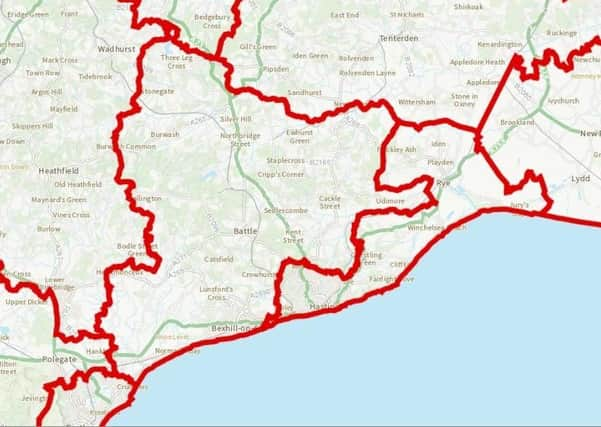Changes to Hastings and Rye’s Parliamentary boundaries proposed


The Boundary Commission for England (BCE) has released initial proposals for the public to have their say.
Hastings and Rye would lose Westfield, Three Oaks, Broad Oak, Udimore and Cock Marling to Bexhill and Battle.
Advertisement
Hide AdAdvertisement
Hide AdBut it would also gain Peasmarsh and Rye Foreign from its neighbouring constituency.
Meanwhile Bexhill and Battle would lose Stone Cross to Lewes and Heathfield to a renamed Hailsham and Crowborough seat.
Each new constituency has to be in the range of between 69,724 and 77,062 Parliamentary electors.
Bexhill and Battle is currently marginally above this at 77,221, while Hastings is well in range at 71,672.
Advertisement
Hide AdAdvertisement
Hide AdThe Commission is required to ensure that the number of electors in each constituency is more equal; in doing so, the number of constituencies in England will increase from 533 to 543.
The Commission is undertaking an independent review of all constituency boundaries in England and will present its final recommendations to Parliament by July 2023.
Members of the public are encouraged to visit www.bcereviews.org.uk to view maps showing the proposed new boundaries and provide feedback before the consultation closes on August 2.
People can comment on anything from where the proposed new boundary lines are to the names of the constituencies.
Advertisement
Hide AdAdvertisement
Hide AdThere will be a further two rounds of consultation in 2022.
Following the conclusion of all three consultation periods, the Commission will look at all the evidence received before forming its final recommendations.
Tim Bowden, secretary to the Boundary Commission for England, said: “Today’s proposals mark the first time people get to see what the new map of Parliamentary constituencies might look like.
But they are just the Commission’s initial thoughts. Help us draw the line to make the number of electors in each Parliamentary constituency more equal. Each constituency we recommend is required by law to contain between 69,724 and 77,062 electors, meaning there will be significant change to current boundaries. We want to hear the views of the public to ensure that we get the new boundaries for Parliamentary constituencies right.”